#Metekhi Bridge
Explore tagged Tumblr posts
Text
Tbilisi Georgia
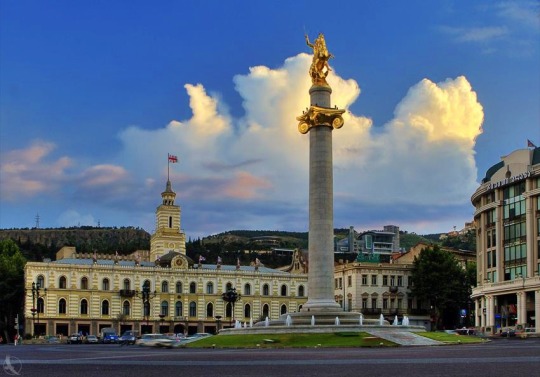
View On WordPress
#Abanotubani Sulfur Baths#Air Serbia#Anchiskhati Basilica#Baratashvili Bridge#Bridge of Peace Tbilisi#Caucasus Mountain Range#Freedom Square#Georgia Parliament Building#Georgian Khinkali#Georgian National Gallery#Georgian National Museum#Hinkali Factory Tbilisi#King Gorgasali#King Gorgasali’s Son Dachi#Liberty Square aka Freedom Square#Metekhi Bridge#Metekhi Church of the Nativity of the Virgin Mary#MOMA Tbilisi#Mt. Mtatsminda#Mtkvari River#Narikala Fortress#National Botanical Garden Tbilisi#Niko Pirosmanashvili Georgian Artist#Open-Air Museum of Ethnography Tbilisi#Orbeliani Square#Project ArtBeat Contemporary Art Space Tbilisi#Sioni Cathedral#Tbilisi Botanical Gardens#Tbilisi Funicular#Tbilisi Georgia
1 note
·
View note
Text
7 Best Things to Do in Tbilisi
Georgian capital, the exquisite Tbilisi, boasts just the right merge of modern, yesteryear, and core culture. Right from the revitalizing sulfur baths to the Old Town's pretty winding streets, this metropolis has a distinct flavor that fits every genre of explorer. A jaw-dropping observation from the celebrated Narikala Fortress, delectable Georgian gastronomy, and primeval fortresses will certainly make Tbilisi a prized experience. As witnessing Tbilisi’s beauty in its entirety within a concise time frame is likely to be somewhat difficult, idyllic Tbilisi tour packages that cover distinguished points of interest will do the utmost justice to one's adventure.
Tbilisi’s 7 Finest Delights- A Primer
Old Town

Tbilisi’s esteemed Old Town is an incredible labyrinth of charming historic monuments, colorful balconies, and gorgeous narrow streets. Wander alongside the nice cobbled lanes to survey hidden courtyards to chic cafes and primeval churches. Stop over to the illustrious Metekhi Church or grab an elating cable car trip to relish Narikala Fortress’s drop-dead gorgeous vistas. This Old Town is an impressive merge of vivacious ambiance and pure Georgian tradition, thus deserving every onlooker’s attention.
Holy Trinity Cathedral
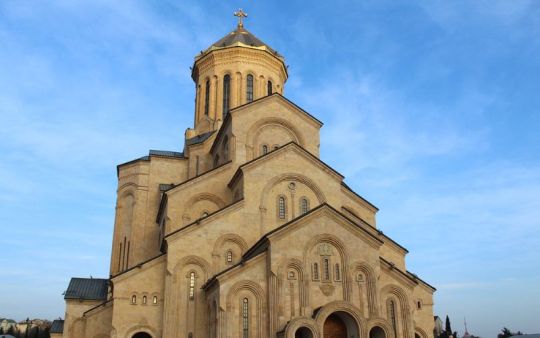
Tbilisi's colossal Holy Trinity Cathedral, dubbed Sameba, is an astounding religious edifice. Placed majestically on the verdant Elia Hill, this cathedral perches atop Tbilisi’s cityscape with its marvelous architecture and polished golden dome. Regardless of being a 21st-century dated structure, this bears the Georgian inclination's impact, a current-day interpretation, and a magnificent Byzantine style. The inside incorporates elaborate carvings to splendid frescoes, lending to an atmosphere that is both spiritually conducive and exquisite. For either sightseeing or some prayer, this place vows an astounding experience, which is featured in numerous travel packages.
Day Bridge Market
Souvenir hunters or fans of antiques, this treasure stomping spot is for you to survey. This flea market is typically open-air and is well-admired for its distinctive mix of eclectic arts, handmade crafts, and, of course, the incredible soviet memorabilia. Stop over each stall exhibiting exquisite jewelry, primeval paintings, antique cameras, yesteryear coins, and the very art creations that tell of Georgia's times of yore.
Sololaki District’s Street Art
This quaint Tbilisi spot brims with unmatched historical charm and astounding street art. Meandering along quiet lanes will lead explorers to the sights of artistic expressions, gorgeous graffiti, and pretty murals that embellish centuries-old walls and structures. Such works mirror Georgia's current-day creativity, profound history, and lovely culture, making this a spectacle of art and documentation. The street art here fuses today’s art with primeval history, something unmissable for those seeking to get an inkling of Tbilisi’s artistic heart.
Ethnography Museum
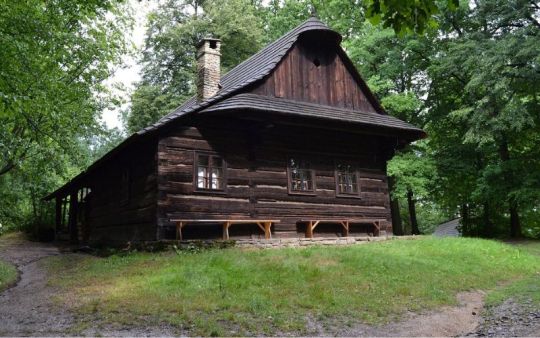
Tbilisi’s outstanding ethnographic museum is a pretty open-air presentation of Georgia’s extensive cultural heritage. Placed on an exquisite hill overlooking the elegant Turtle Lake, a spot where artifacts as well as traditional housing from Georgia’s variegated parts are exhibited. Explorers will get pleasure from meandering through authentic charming wooden houses, witnessing craft demonstrations, and familiarizing themselves with primeval life. This museum features an attention-grabbing peek into Georgian traditions, unmatched architecture, and beautiful history.
Savor Georgian Wine
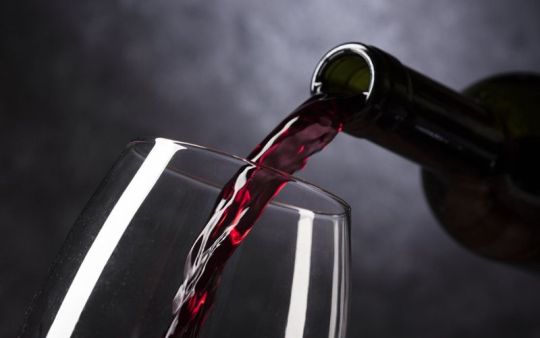
This is just the right enclave for adorers of wine, making it amidst the indispensible things to do in Tbilisi. Vino Underground, a chic, atmospheric, well-admired wine bar, is famed for its lip-smacking natural Georgian wines, presenting a range that is carefully crafted from organic producers. Visitors can take pleasure in guided wine tastings and familiarize themselves with Georgia's winemaking history, which is some eight millennia long. The rustic, warm vibes act as an idyllic repose for every explorer's pleasure. Be it a curious voyager or an admirer of rich wine, this spot is indeed a fitting preface to Georgia's incredible wine culture.
Abanotubani’s Sulfur Baths

An up-close encounter with Abanotubani’s famed sulfur baths ought to be on each explorer’s checklist. The sulfur-rich, naturally heated water is replete with untold therapeutic perks, assuring skin restoration as well as some relaxation. People can opt from private to public baths, typically presenting striking mosaics and incredible Persian-style domes. Soaking in such mineral-infused, tepid waters is purely an encounter and a revitalizing one in Tbilisi’s core.
Conclusion
Discovery, along with exploration, are congruent with Tbilisi city, making it amongst the central things to do in Georgia.This metropolis resonates with each voyager owing to its awe-inspiring landscapes, vivacious culture, and rooted history. From the sulfur baths’ composed setting to the Old Town’s charismatic lanes, Tbilisi’s every inch uncovers a narrative awaiting to be unfurled. For visitors planning their expedition through Georgia should make this metropolis the chief highlight of their venture, revealing the finest of what this astounding place has to present.
0 notes
Text
Tbilisi
given how far east we'd travelled we were expecting Tbilisi to be an Asian city, sort of Uzbekistan-esque - but it had a very European feel, much more Ljubljana than Tashkent
the old city is laid out along the Kura river, local landmarks include the Metekhi church and statue of Saint Vakhtang Gorgasali, a 6th century king who's a key figure in the Georgian origin story

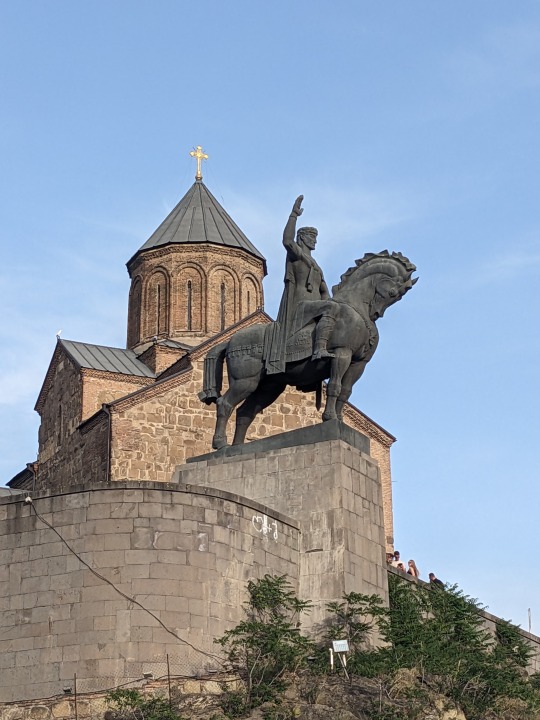
the clock tower, a relatively modern building attached to a famous puppet theater
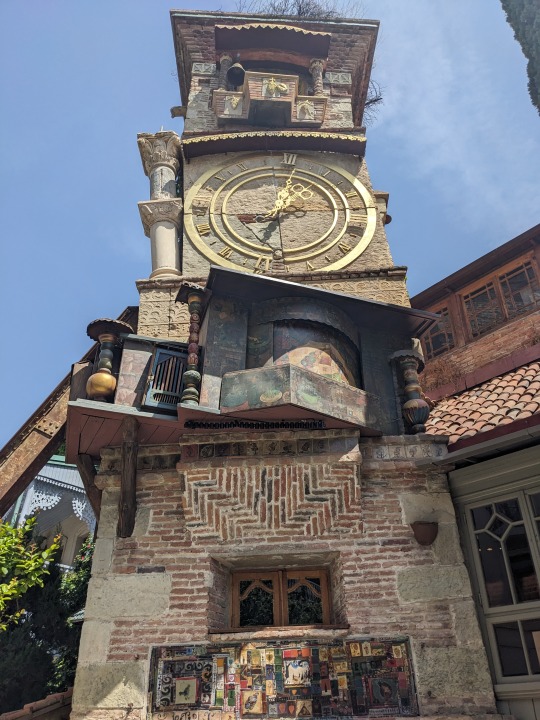
the native language monument in Dedaena Park, commemorating a 1978 protest against the imposition of Russian as the official language of the country
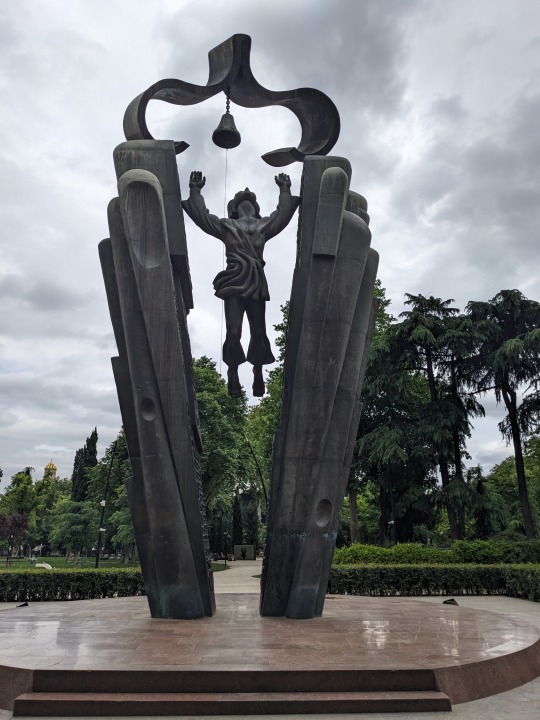
the Peace Bridge was built with Italian money and design, looks very incongruous
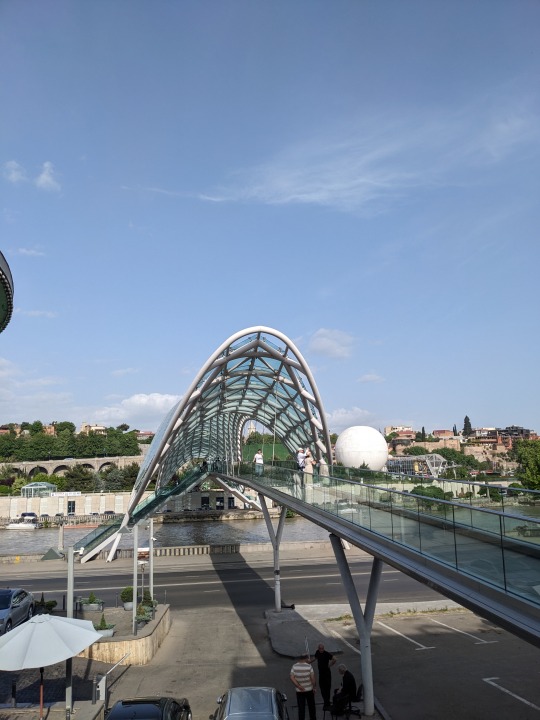
Georgia was under Russian control from 1921 when the Red Army invaded until secession from the Soviet Union in 1981, followed by 10 years of economic crisis, political instability, wars for independence in South Ossetia and Abkhazia. The Rose Revolution in 2003 turned the country towards Europe and relations with Russia deteriorated until war broke out in 2008, but the pendulum is now swinging away from Europe and back towards Moscow. Given the Russian influence there are surprisingly few Soviet buildings - this one, Fabrika, is an old sewing machine factory which is now a hostel and community centre
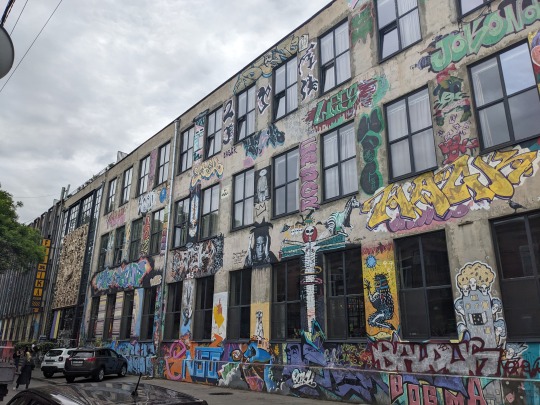
there are viewpoints over the city from Mtatsminda, where there's a very low key amusement park

and from the Narikala Fortress, which also has a 20 metre tall Kartlis Deda sculpture, the symbol of Tbilisi - sword in one hand, wine glass in the other
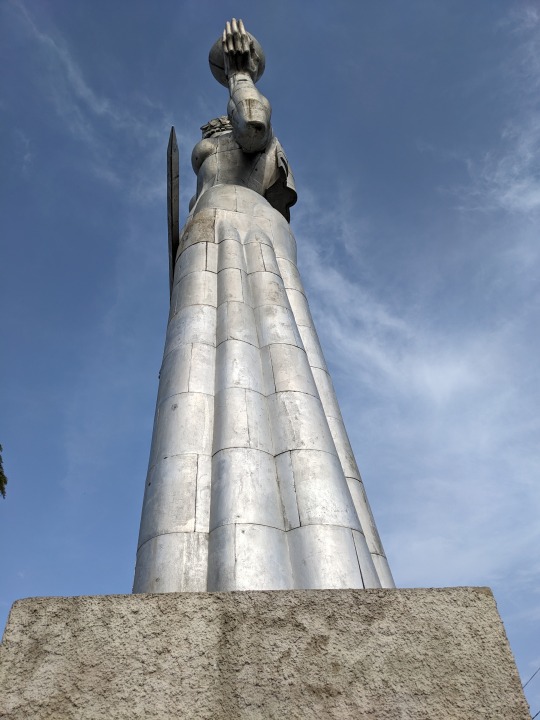
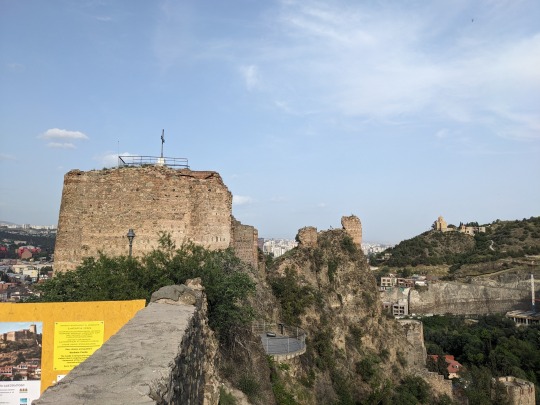

overall a very pleasant city, nice to walk round, english widely spoken and lots of good (and cheap) restaurants

0 notes
Photo
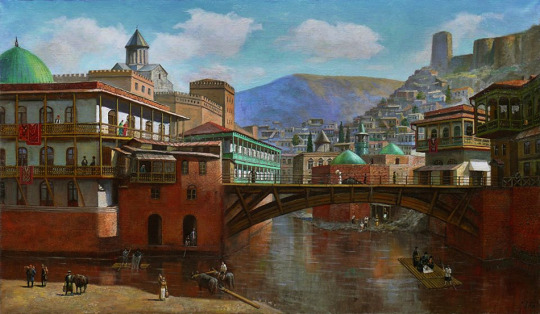
Giovanni Vepkhvadze - Metekhi Bridge, Tiflisi
2 notes
·
View notes
Text
Day 9, Tbilisi, 16th May.
What a wonderful day we had walking around Tbilisi. We covered a lot of different areas, did thousands of steps, climbed unknown numbers of stairs, went on an Aerial Tramway and finished the day with a ride on a Funicular. The weather was perfect and Davit, our guide was fantastic. He has a lot of patience and excellent stories to relate about places. I think we are lucky being only a group of 13 as I’ve heard that other Trip a Deal tours have many more people on them. It’s easy for us to get around and everyone is getting on so well that we mostly spend our free time together. At night we have drinks then all go to a restaurant. Tbilisi is the capital of Georgia and has a population of 1.5 million. Like any country in this region their history is long, complicated and bloody at times. You wouldn’t know it walking around the city today, though. . Davit is 34 and comes from Tbilisi and he said in his lifetime he has gone through three revolutions and four wars. That’s crazy to imagine.
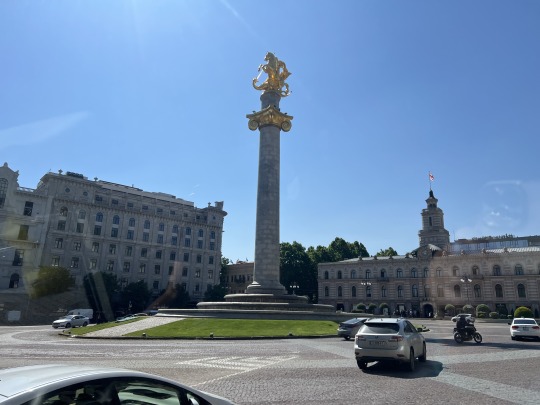
The Peace Bridge.
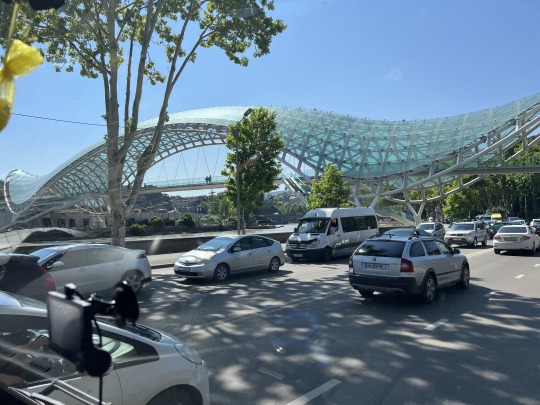
Street scene.
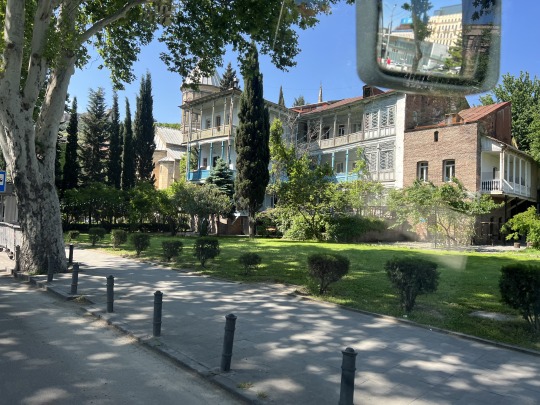
Metekhi Holy Church which sits on the cliff face.
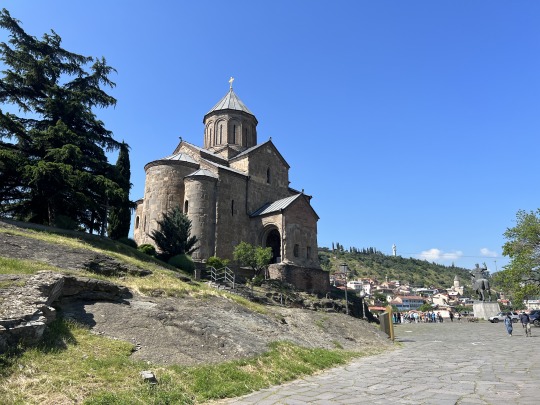
High on the hill is the remains of the 4th Century Narikala Fortress which when up there gives panoramic views of the city. We caught the aerial tramway up and then walked down into the old city below.
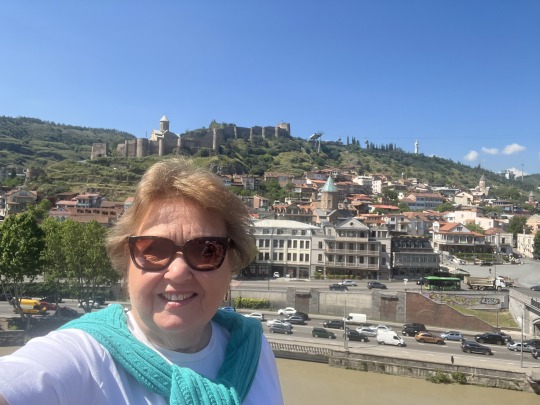
The king who saved Georgia.

Beautiful chandelier in the church.

Signature and dates of prisoners held in the church grounds.
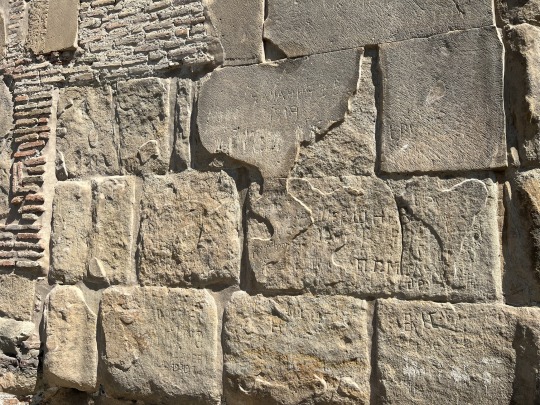
A piece of the Berlin Wall. Apparently the Georgian Prime Minister at the time in the early 1990’s had a big import on bringing the Berlin Wall down.
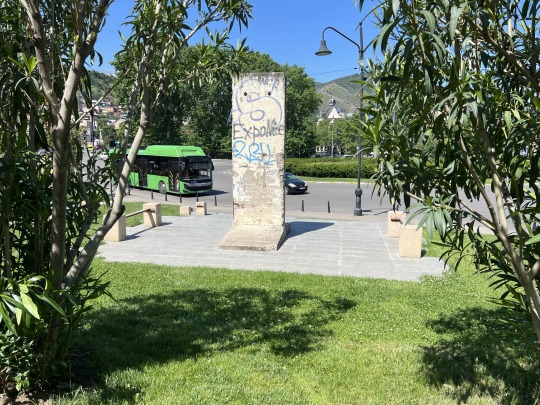
A sculpture called the Tree of Life.
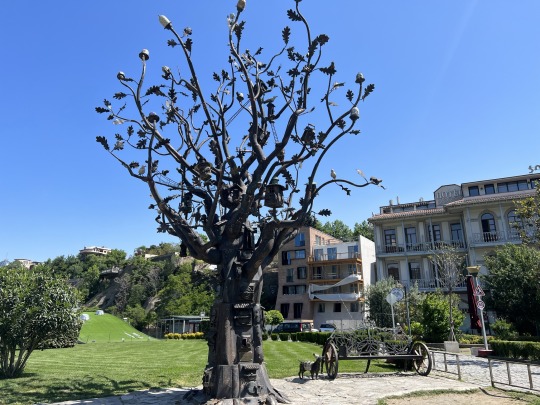
Looking over the city with the Peace Bridge crossing the river in the middle.
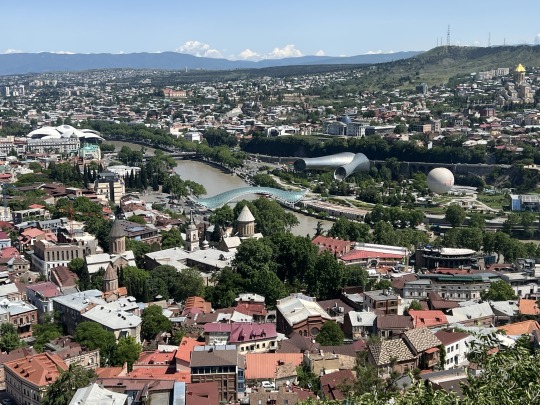
Poppies
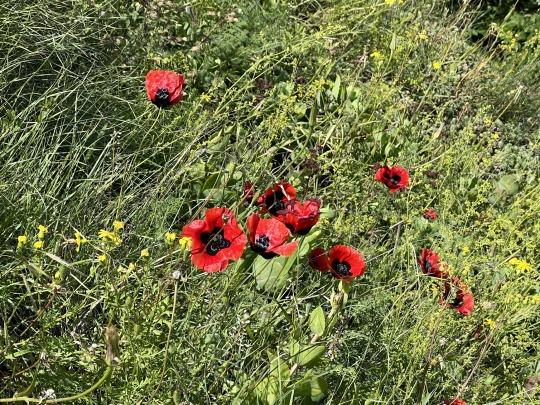
The church and its grounds were once used as a prison around WWI.
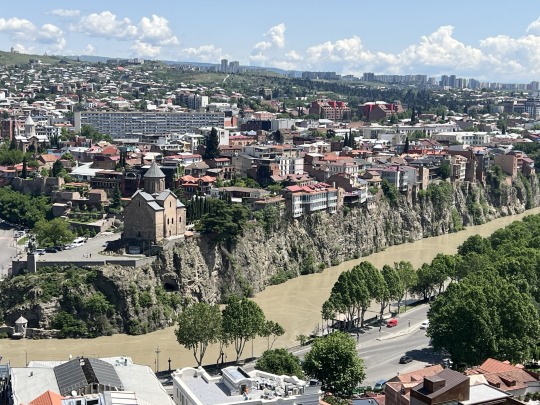
Below the fortress are the historic bathhouses with pools of hot, sulfur rich water. Women could stay in the baths all day. It was their own private place and many social activities went on there. Match makers made dealings and the fate of many beautiful women was decided in the baths.
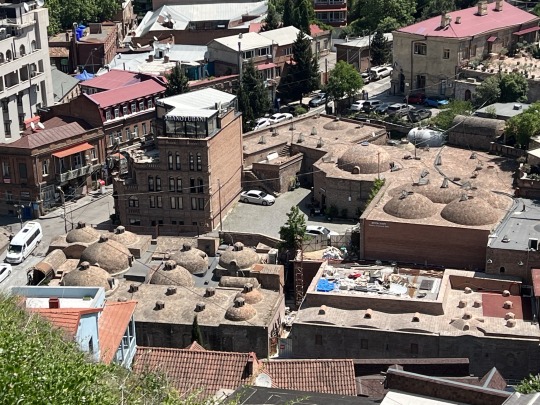
These bathhouses are still operational.
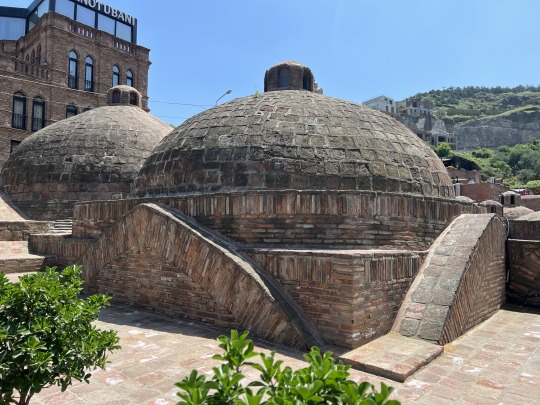
Close up of tiles on the bathhouse wall.
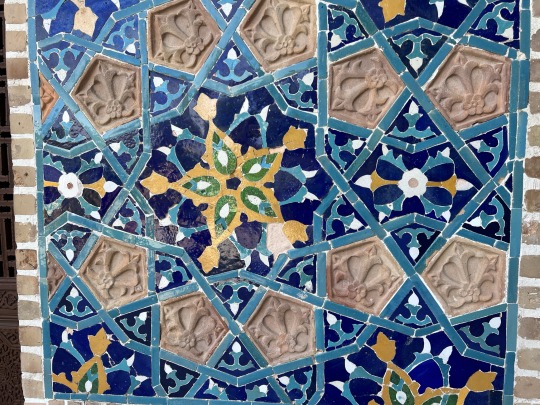
Mosque

I love the detail and verandahs on these buildings.

We stopped in a cafe across from these buildings on our walk.

Interesting streets.

In the old city people tended to live around courtyards which were called Italian courtyards.

Narrow streets

The old underground bazaar.

These narrow streets were wall to wall restaurants and bars.

Carpet shops.

Walking across the Peace Bridge.

The Bridge of Peace is a pedestrian bridge which spans the Mtkvari River and was opened 2010. The bridge was designed by an Italian designer Michele De Lucchi and was bought to Georgia from Italy in 200 unassembled components. The bridge has 10,000 LED bulbs which are switched on before sunset.

Looking down on the city from the funicular which was built in 1938.

Lovely restaurant that Davit suggested. The waitress was wonderful.

Restaurant lit up at night. We got a taxi back to the hotel. It cost about $4 between five of us.

0 notes
Photo

Metekhi bridge , Tbilisi, Georgia 🇬🇪 04.04.2020 By : @dahab_web #nature_lovers #nature_brilliance #amazing #view #trip #tree #mountains #toptags #mountainbike #mountaindew #clouds #cloud #cloudporn #weather #toptags TOp #photogram #instagood #photooftheday #photoeveryday #instafamous #100likes #nofilter #bestoftheday #nature #toptags #theoutdoorfolk #landscape #mountain TOP #amazing #style (at Metekhi Bridge) https://www.instagram.com/p/B-sZZ_IJA4g/?igshid=7wen5rwrsul7
#nature_lovers#nature_brilliance#amazing#view#trip#tree#mountains#toptags#mountainbike#mountaindew#clouds#cloud#cloudporn#weather#photogram#instagood#photooftheday#photoeveryday#instafamous#100likes#nofilter#bestoftheday#nature#theoutdoorfolk#landscape#mountain#style
0 notes
Text
20 beautiful European cities with few tourists
(CNN) — With overtourism showing no signs of abating in Europe’s most famous destinations, there’s never been a better time to seek out wonderful options that attract fewer visitors. Keen to travel somewhere new without having to battle through huge crowds of selfie stick-wielding tourists in the likes of Venice, Paris and Amsterdam?
Here’s our pick of the most beautiful European cities with hardly any tourists:
Orange, France
While Avignon draws in thousands of tourists thanks to its summer festival and arresting Papal Palace, nearby Orange is usually overlooked.
Easier to navigate with far fewer visitors, the city’s key attraction is the vertiginous Roman theater, which was built in the first century C.E. Meanwhile the Orange Museum, set in a beautiful 17th-century mansion, is also well worth a visit.
Norwich, England

Norwich has one of England’s most impressive cathedrals.
Pixabay / Creative Commons
The saying goes that Norwich has a pub for every day of the year and a church for every Sunday.
While that’s perhaps stretching the truth, this most quintessential of English cities is certainly home to some of the most stunning medieval architecture in England.
Norwich Cathedral dates back to 1096 and the streets of Colegate and Elm Hill are home to picturesque, centuries-old homes.
The Adam and Eve pub, on Bishopsgate, is said to be the oldest pub in the country, dating back to 1249.
Aarhus, Denmark
Denmark’s second city has long been overshadowed by its alluring capital Copenhagen.
But Aarhus makes the perfect alternative for a Danish long weekend thanks to its pretty beaches, towering Domkirke and the superb ARoS Aarhus Art Museum, with its rainbow panorama walkway.
For those looking to splash out, Gastromé,based in the Latin Quarter, has a tasting menu that will satisfy the most demanding of foodies.
Antwerp, Belgium
The UNESCO-protected Cathedral of Our Lady dominates the Antwerp skyline, but there’s so much to this Belgian city than its most famous building.
Highlights include the diamond Square Mile, where travelers can get to the heart of an industry that’s been a core part of the city since the 15th century.
There’s also the Red Star Line museum, located on Antwerp’s old docks, which uncovers the city’s past as a hub for migration to the United States in the late 19th and early 20th centuries.
The Hague, Netherlands

Laid-back city The Hague is far less crowded than Amsterdam.
Pixabay/Creative Commons
As Amsterdam attempts to rein in tourists with plans to close its Red Light District and impose strict rules on short-term lets, the Hague serves as a fabulous, low-key alternative for those still keen on a Dutch break.
The city boasts some of the Netherlands’ finest architecture, a pretty network of canals and, in the Mauritshuis, a museum to rival Amsterdam’s behemoth Rijksmuseum.
It’s also just 15 minutes away from the gorgeous Scheveningen beach resort.
Sarajevo, Bosnia

Sarajevo is filled with stand-out architecture.
Pixabay, Creative Commons
Often snubbed for more popular destinations in neighboring Croatia, Sarajevo is a resurgent city brimful of culture and history.
At its heart is Baščaršija, the old market quarter that still buzzes with spice stalls, cafés and the fascinating Gazi Husrev-beg Mosque.
Visitors can learn about Sarajevo’s four-year-long siege during the 1990s civil war at the Tunnel of Hope and the War Childhood Museum. The derelict bobsled track from the 1984 Winter Olympics is also a stand-out sight — the nearby Pino Nature Hotel offers superb views and first-rate Bosnian food.
Pristina, Kosovo

Kosovo’s capital is a quirky city with plenty to see and do.
Shutterstock
The Kosovan capital isn’t usually at the top of many tourists’ destination wish lists, but that’s no reason not to visit this fascinating city.
While Pristina may have been synonymous with war 20 years ago, its undergone a major transformation since then, with various quirky buildings popping up.
The excellent Emin Gjiku Ethnographic Museum is well worth a morning of exploring, as is the superb National Museum of Kosovo.
Pristina University’s unique library will fascinate architecture buffs, while those looking to cool off can find solace in the vast pool tucked away in Germia Park, located just north of the city.
Malmo, Sweden

Malmo — the third largest city in Sweden after Stockholm and Gothenburg.
Shutterstock
Malmo is so much more than a day trip across the Oresund Bridge from Copenhagen.
The excellent Moderna Museet Malmo is one of the best contemporary art galleries in Europe, while culture fiends will find succor at Malmöhus Castle, home to several museums focusing on the local area. The city’s food scene rivals the nearby Danish capital — foodies should check out Bloom in the Park and its “no menu'”concept, as well as the global offerings at Malmö Saluhall.
Meanwhile Ribersborg beach, located just a short walk from the city center, is a wonderful haven from the heat in high summer.
Aberdeen, Scotland

Aberdeen is often referred to as “The Flower of Scotland” thanks to its greenery.
Shutterstock
The hordes visiting the Scottish capital can feel hugely oppressive, particularly during its annual festivals.
However, travelers keen to escape the crowds can simply head north to Aberdeen instead.
The city’s amazing architecture has given rise to the nickname “Granite City,” with fascinating buildings at every turn.
Aberdeen’s main art gallery is due to reopen in November 2019, while those keen to sample the local culture can head out to nearby Speyside for a tour of some of Scotland’s best single malt distilleries.
Bern, Switzerland

The Old Town of Bern — a UNESCO World Heritage site.
Shutterstock
While travelers often simply pass through the Swiss capital en route to a summer vacation or winter ski trip in Zurich or Geneva, Bern is definitely worthy of a few extra days of your trip.
When the heat rises, locals take to the River Aare for cooling dips and paddle board trips.
Elsewhere, the Museum of Fine Arts features works by Picasso and Klee, while hikers can tramp to the top of the Gurten, the mountain which overlooks the old city.
Wroclaw, Poland

Wroclaw is one of the oldest cities in Poland.
Sean Gallup/Getty Images
Few small cities in Europe pack a cultural punch like Wroclaw.
This western Polish city, on the banks of the Oder river, served as European Capital of Culture in 2016 and has plenty of attractions for art, architecture and history fanatics to marvel at.
Wroclaw’s main highlight is the 114-meter Panorama of Racławice, depicting the 1794 defeat of a Russian army by the Poles.
The beautiful Centennial Hall should also be on any itinerary, as should the Penitent Bridge between the towers of the Mary Magdalene Church.
No visit is complete without a day spent exploring the Gothic Old Town.
Tbilisi, Georgia

The name of Georgia’s capital comes from the Old Georgian word “tbili,” which means warm.
Pixabay/Creative Commons
The capital city of Georgia, which is actually positioned between Asia and Europe, derives its name from the hot springs that bubble beneath its surface.
Its sulfur baths are a magnet for visitors, albeit far fewer than those that head to the famous spas.
Tbilisi wears its multi-ethnic history with pride — the famous Metekhi Church, which dates back to the 13th century, sits close to the Narikala Fortress, built by the occupying Persians in the fourth century.
Meanwhile, the rambling alleyways and small shops of the Old Town are perfect for whiling away the hours.
Minsk, Belarus

The Belarusian capital of Minsk is another city that’s usually relatively crowd-free.
Dan Kitwood/Getty Images
Having been almost destroyed during World War II, the now Belarusian capital became fertile ground for Soviet redevelopment.
Today, the city’s buildings offer a fascinating glimpse into a bygone era of brutalist buildings.
Travelers can wander around the vast, seven-hectare Independence Square before taking in the Museum of the Great Patriotic War, which looks at how Belarus overcame Nazi occupation.
Minsk’s bar scene is legendary, and if the acquired taste of local tipple Balsam doesn’t suit, the excellent Gambrinus has a variety of beers to try after a day’s sightseeing.
Yerevan, Armenia

Yerevan — one of the world’s oldest continuously inhabited cities.
Maja Hitij/Getty Images
The Armenian capital’s position in the far eastern reaches of Europe means it’s easily forgotten by those on the tourist trail.
But with a history going back more than 2,800 years, there’s a palpable sense of the past here, without the shoulder-to-shoulder crowds of regular tourist hotspots.
Its downtown area is a mix of Beaux Arts buildings and hulking, Soviet-era blocks.
Cluj-Napoca, Romania

Cluj-Napoca is filled with fascinating Baroque and Gothic architecture.
Pixabay, Creative Commons
Romania’s second largest city is often seen as a stop off for travelers looking for outdoor adventures in the Apuseni Mountains, or those keen to witness Transylvania’s historic sights.
But the vast, Gothic St. Michael’s Church and the fascinating Fabrica de Pensule, a working gallery and art space in a former paintbrush factory, are just two attractions that make a longer stay essential.
Throw in a thriving café and bar scene and pretty squares, and Cluj-Napoca has all the trappings of the ideal city break destination.
Debrecen, Hungary

Debrecen is a less crowded alternative to Budapest.
Shutterstock
While Budapest has a deserved reputation as one of Europe’s most appealing cities, Debrecen is an excellent option for those seeking a less crowded Hungarian alternative.
Kossuth tér, the main square, is home to the impressive Calvinist Great Church and Grand Hotel Aranybika.
Yet it’s beyond these major sights that the real action takes place.
The Old Town rewards those looking to get lost with excellent cafés and people-watching spots.
Keep an eye out for smaller spa hotels, with a chance to soak in thermal waters before heading to the nearby Great Plains.
Ankara, Turkey

Ankara, formerly known as Angora, is the second largest city in Turkey after Istanbul.
Adem Altan/AFP/Getty Images
When it comes to city breaks, Istanbul tends to take all the plaudits.
But capital city Ankara is so much more than a stop off on the way to Cappadocia and the other delights of Anatolia.
Anitkabir, the mausoleum of modern Turkey founder Ataturk, is an obvious starting point, along with the Museum of the War of Independence.
The Kocatepe and Hacı Bayram Mosques are also key attractions, while the cafés of Kızılay are ideal spots to grab a kebab and watch the world go by.
Plovdiv, Bulgaria

Plovdiv — the first Bulgarian city chosen as European Capital of Culture.
Shutterstock
Currently enjoying its time in the limelight as a European Capital of Culture, Plovdiv is Europe’s longest inhabited city.
As a result, it’s imbued with an inescapable sense of history, especially in the colorful Old Town.
The main draw here is the astonishing second-century Roman amphitheater, which wasn’t uncovered until the 1970s.
Another highlight is the Thracian ruins of Eumolpias, located just outside town and dating back 5,000 years.
Trondheim, Norway

This historic city was Norway’s first capital.
Martin Bureau/AFP/Getty Images
Located on the fjord of the same name, Trondheim is Norway’s third largest city.
However, with fewer than 200,000 residents, it’s decidedly uncrowded and easy to explore.
The famous Gothic cathedral is perhaps its best known sight, but the views across the water and around its vibrant harbor are just as impressive.
Trondheim is also known for its excellent microbreweries — Den Gode Nabo is popular and a great place to start.
Turin, Italy

Turin is home to incredible sights like the Mole Antonelliana.
Pixabay/Creative Commons
Venice’s struggles with tourist numbers have been well documented, but while still popular with travelers, nearby Turin is decidedly less congested.
Travelers can simply sip a coffee on the sidewalk, indulge in some of the country’s best cuisine and enjoy being away from the hordes in the country’s hot spots.
The post 20 beautiful European cities with few tourists appeared first on Tripstations.
from Tripstations https://ift.tt/2Gywb5I via IFTTT
1 note
·
View note
Text
Sweet sweet Georgia.
Today (27th June), we head out of Azerbaijan to the next country on the tour, Georgia and its Eastern Kakheti region. Georgia is a relatively small country situated between the two Caucasus mountain ranges. Not the best start with bus issues leading up to the border.. but we got through! The border between the two countries is not set up for tourist buses so we had to walk our luggage the very hot 600m or so uphill to get from Azerbaijan to Georgia. We then met our new guide for our time in Georgia, the lovely Leila, and jumped on a new bus ready to head off to our first stop - Khareba winery. Knowing that was our first stop makes the hot border crossing worthwhile... Georgian wine history dates back over 8000 years, and involves a different wine making process to that used by European wine makers. It involves using all of the grape that is fermented together, stirred regularly, in large (200litre and larger) underground egg-shaped clay pots. According to our guide the word “Vino” actually came from the Georgian “Ravino”. It was shortened by the Greeks as they did not have a rolling “r” in their language. Our tour of the winery gave us an overview of the production process, as well as the all important tasting. Don’t tell anyone, I’m not a massive fan of Georgian wine... it has a very distinctive flavour that isn’t really to my taste...


After surviving our tasting, we headed to see the 16th Century citadel and church of Gremi, the capital of the Khaketi region. These are the only remaining remnants of the old town of Gremi, once a lively trading town on the Silk Road. The original Gremi was razed to the ground in 1615, by the armies of the Shah Abbas I of Persia, and it never regained its stature. The area is one of the most tourist visited sights of Georgia, and the history blows my mind. You can still see the ruins of the old town. Amazing space, beautiful views, incredible structures.


With glorious views of the Alazan valley we then headed to Signagi, Georgia’s very own ‘city of love’. It’s known as this because it has a government office in the main square where you could get married within 10 minutes. On another note, there is an 11% divorce rate in Georgia, so maybe quickie weddings work! Leila then took us on a walking tour of the cobbled streets lined with their cute little pastel houses and along part of the fortress wall of the 17th century city. It was a charming little town set amongst some hilly terrain. We then set of for our hotel in Batumi to rest (maybe drink wine...) ready to go to the capital of Georgia, Tbilisi, the next day.


Tbilisi. Friday 28th June. Wow, what a city. With it’s Sulphur baths, leaning clock tower, 13th century Metekhi church, 4th Century Narikala fortress, Sioni cathedral and a variety of museums. You can clearly see the ‘old town’ area sprawling beneath the giant statue of Mother Georgia. A stark contrast to some of the astoundingly modern structures spread around the city centre.

We arrived in time to grab some lunch from one of the local restaurants dotted near the space age looking ‘bridge of peace’, a pedestrian bridge over the Kura river that was opened in 2010. Our tour representative gave us some great tips on local cuisine for lunch and we tried some fantastic food. Khinkali was the big one we wanted to try. They are traditional Georgian dumplings traditionally stuffed with meat and spices. (Also known as nipples) Somehow we ordered a plate of each flavour, including cheese, mushroom and non spiced meat. Oops! we thought they were only small - the waiter gave us a size that seemed a lot smaller than what came out! We added to the menu with some fabulous veal, chicken livers and some beans in a pot - omg yum. So much food... Lucky we were doing a walking tour later that day! Once we’d stuffed our faces we had time for a little walk through the pedestrian area, then we were off to check in to our hotel for the next 3 nights...


The walking tour saw us take the cable car to the top of the old town and fort area, taking in the fabulous views of the city, as well as the huge stature of Mother Georgia. The statue was erected on the top of Sololaki hill in 1958 as part of celebrations of Tbilisi’s 1500th anniversary. In her left hand she holds a bowl of wine to greet those who come as friends, and in her right hand is a sword for those who come as enemies. We then headed down towards the fortress, eventually winding our way down the stairs to the central mosque then onwards towards the Leghvtakhevi waterfall. While waiting for some of the group to catch up myself and our tour rep discovered the wonder that is wine ice cream....Yes, ice cream with a distinctive taste and colour of red wine...amazingly delicious! After reaching the love lock bridge and the water fall area, and finally working out that it was the frogs making the very loud noise in the creek bed below, we then walked past the original sulphuric baths and then back to the hotel.

A few of us (3), then headed out to have one of the most amazing meals ever - fresh Georgian crayfish. They are crayfish particular to this region, cooked to order, and just delish! A fantastic night with an introduction to the local drink called ‘Chacha’ - lets just say it’s similar to Grappa or Raki, something to burn your insides.... had a ball though.
More photos to come!
0 notes
Text
Tbilisi Walking Tour & Georgia Independence Day
Narikala Fortress – Tour to Georgia Having time to move at your own pace is a big plus when traveling abroad. Long-term travel provides time for adjusting to new environments, without feeling pressed to see everything at once. I’ve been low-key for a few days getting my bearings, but am getting up to speed and expanding my Georgian horizons. Transportation Purchasing a Metromoney card seemed a…

View On WordPress
#Abanotubani Neighborhood#Abo Patron Saint of Tbilisi#Act of Independence 1918#Ancha Monastery#Anchi’s Icon#Anchiskhati Basilica of St. Mary#Anchiskhati Church#Art Museum of Georgia#Bridge of Peace#Cathedral of the Assumption#Caucasus#Clock Tower Puppet Theatre#Day of the First Republic#Foreign Influence Bill Georgia#Georgia President Salome Zourabichvili#Georgian Parliament#Georgian sculptor Elguja Amashukeli#Historic District Old Tbilisi#Italian architect Michele De Lucch#Juma Mosque#King Gorgasali Founder of Tbilisi#King of Iberia Dachi Ujarmeli#King Vakhtang I Gorgasali#Kingdom of Iberia 4th century BCE#Klarjeti#Leghvtakhevi Canyon#Leghvtakhevi Waterfall#Liberty Square Tbilisi#May 26 Georgia Independence Day#Metekhi Church of the Nativity of the Virgin Mary
0 notes
Photo

View from the Georgian capital of Tbilisi. This is looking out, across the Metekhi bridge, which crosses the Mtkvari river and connects the Avlabari area the Old Town. Discovered at Metekhi Bridge მეტეხის ხიდი, Tbilisi, Georgia. See more at Trover
0 notes
Photo

Night walks are best whether the path is lighted by the stars, moonlight or city lights. #WhereEarlYou #earlventures (at Metekhi Bridge)
1 note
·
View note
Text
What to see in Tbilisi in 3 days - 18 most interesting places
New Post has been published on https://tripsterguru.com/what-to-see-in-tbilisi-in-3-days-18-most-interesting-places/
What to see in Tbilisi in 3 days - 18 most interesting places
Ancient, freedom-loving, hospitable Georgia always beckoned with the extraordinary beauty of mountain ranges, ancient temples, the cordiality and unchanging sense of humor of its inhabitants and special culinary traditions. It is no coincidence that the name of the capital “Tbilisi” translates as “warm”. Warmed by the sun, this city is good at any time of the year. If you have three free days, go to Tbilisi for a charge of positive and new experiences. This city is very convenient to just walk. You can go where your eyes look and discover a city from a new, unexpected side, or you can plan a route in advance so you don’t miss anything. We have prepared for you a route to the most interesting places in the capital of Georgia. So, we will tell you what you can see in Tbilisi in 3 days.
How to get from the airport to the center
Tbilisi International Airport is located at the eastern end of the city. There are several ways to get from it to the center.
A taxi will cost you from 20 to 30 GEL, depending on where you are going to go – to the center (say, to Freedom Square) or to the northern regions. To call a taxi, you can use the Yandex taxi application or taximaxim. The difference is only in the method of payment. In the first case, this is a transfer to the card, in the second – cash. The trip will take no more than 25 minutes, in the summer it can stretch up to 40-50 minutes, especially in the high season.
If you need to get to another city from the airport, you can order an online transfer. Here are the most popular routes in order of increasing price: to the city center ($ 12), to Gudauri ($ 45), to Bakuriani ($ 54), to Batumi ($ 80).
If you travel without children, and you do not have a mountain of suitcases, it is quite possible to opt for public transport, namely bus number 37. The stop is located three meters from the arrivals area. BUS is written in large letters on the pavement, so the likelihood that you will be lost is extremely low. The fare will cost you 0.5 GEL.
Buses run on the route from 7 a.m. to 11:35 p.m. You won’t have to wait long – they come every 15-20 minutes. In the summer, they continue to walk at night. Avlabari metro can be reached in 40 minutes, to the train station (final stop) – in an hour.
1 day
Freedom Square and Pushkin Square
The main square of Tbilisi is at the junction of three urban areas. Once there were gardens of the local nobility, but in the XIX century they were cut down and covered with an old ravine. The resulting area was called at that time Erivan. In one of the houses standing on it, A.S. Pushkin lived for 2 months in 1829, now a square located nearby is named after him. After the revolution, the square changed its name several times, bore the name of Lenin and Beria, and in our time it has received its modern name – Freedom Square.
The square became the center of many dramatic events in the history of the country. Today, there are administrative government buildings, the central branch of the national bank, hotels, shops and numerous souvenir shops. In Pushkin Park, you can relax on the benches at the fountain, book dealers often gather here, and a tourist information center works. Behind the park, in the square is the Museum of Art. Once upon a time, a theological seminary was located in this building, in which I. Dzhugashvili studied.
Tbilisi funicular
The funicular in Tbilisi is not only a vehicle that allows you to climb Mount Mtatsminda, but also one of the main attractions of the city. Once upon a time, the famous “son of a Turkish citizen” rode on it. To travel by funicular, you need to buy a ticket, the cost of which is 2 GEL, and after midnight – 3. It has 3 stops. If you go to the second, you will get to the Church of St. David and the Pantheon, and the third stop – the final goal of his route – is Mtatsminda Park.
Pantheon
Here, on Mount Mtatsminda, near the Church of the Holy Father David is the Tbilisi Pantheon. The church was built on the site of the destruction of the rock of St. David. According to legend, in the 5th century there lived an ascetic David, who descended from the mountain to the city only on Thursdays. A necropolis was organized near the walls of the temple, which now bears his name, in which the most prominent representatives of Georgian culture and public life are buried. It takes its history from 1829, when, on the initiative of Princess Nina Chavchavadze, her husband, Russian poet and public figure Alexander Griboedov was buried here. On the centenary of his death, in 1929, the Pantheon was opened here.
Here is the grave of Nina Aleksandrovna Chavchavadze-Griboedova, the great Vazha Pshavela, Veriko Anzhaparidze, Ilya Chavchavadze, Vakhtang Chabukiani, many public and political figures. In the Pantheon you can find a tablet with the name of Niko Pirosmani, but he is not here, because the burial place of the famous artist remained unknown. Near the Pantheon at the crevice of the cave in which St. David of Gareja lived, there is a holy spring. Make a wish, soak a pebble in water and attach to the wall of the temple. If he holds on, then your desire will certainly come true.
Mtatsminda park and observation deck
As early as the 19th century, Tbilisi began to travel to Mount Mtatsminda in the summer (its name translates as “Holy Mountain”) for picnics. So, gradually it became a favorite vacation spot of citizens. Many restaurants and cafes have appeared here. In the 30s of the last century, the mountain slopes were planted with trees. Today there is a large park with attractions for children and adults, a water park, a dinosaur park and a large Ferris wheel. Climb to the observation deck to enjoy an extraordinary view of the city. From here, Tbilisi is perfectly visible, especially its old part.
Puppet Theater Rezo Gabriadze
One of the main attractions of the Shavteli pedestrian street is the Rezo Gabriadze Puppet Theater located on it. His performances are known far beyond the borders of Georgia. To get to them in the Georgian capital, you need to buy tickets in advance. Rezo Gabriadze is already practically a cultural heritage, not only Georgian, but also world heritage. This playwright, artist and sculptor created his own special world, by touching which you will begin to look at life with completely different eyes. The theater program has just four performances. All the dolls are made by the artist himself, just as the plays were invented by him.
The theater building, created in 1981, cannot be overlooked. It is decorated with a clock tower. Every hour a door opens in it, and an angel strikes a bell with a hammer. And twice a day – at 12 p.m. and 7 p.m. – a mini-play “Life Cycle” is played here. The turret is decorated with tiles, painted by the artist himself, and a pomegranate tree grows on its roof.
The motto of the artist’s life “Let the tears be with us only from the bow” is recorded on the pediment of the theater building. Near the theater there is a cafe, the interiors of which were painted by the artist. Once it was the size of a small room and was called “Do not Cry!”, But it has gradually grown and is now called simply “Gabriadze.” Plots and phrases from famous films are written on tables and chairs, in which the artist participated as a screenwriter for Mimino, Kin-Dza-Dza and others.
Chawteli street
Another pedestrian street in the old town. It is named after the medieval Georgian poet, who lived during the time of Queen Tamara, John Chavteli. Once it was the very center of the city, the royal palace stood here, and in front of it the main palace square. This area was very prestigious in those ancient times. Near Tsarskaya Square, noble citizens and nobles built their houses. Both the square and the palace were completely destroyed in 1795 during the invasion of the Persian Khan Aga Mohammed.
Now the buildings of the Georgian Patriarchate are located on this place, inside it is the active convent of the Blessed Virgin Mary, opposite the old church of St. George, which served as the main court church from the 17th century. In addition to it, all the buildings on the street date back to the 19th century, almost nothing remained of ancient houses, palaces and churches. Here, on Shavteli Street, is the famous Puppet Theater Rezo Gabriadze, and in the park opposite the Church of St. George there is a small fountain – a gift to the city from the French capital.
2 day
Cathedral of the Holy Trinity, or Tsminda Sameba
The cathedral of the Georgian Orthodox Church is visible from anywhere in the city. He stands on the hill of St. Elijah on the banks of the Kura. This is the tallest temple in Georgia – its height is 101 m. The cathedral dates back to 1989, when it was decided to build it, associated with the celebration of the 2000th anniversary of Christianity. But due to the difficult years that followed, especially the events of the civil war in Georgia in 1992, the construction was postponed and the construction of the temple began only in 1995.
The first service was held here in 2002 near Christmas, although the temple was not yet completed. They consecrated it in 2005 after completion of construction. The complex includes 9 chapels, most of which are located underground, a bell tower, theological academy, the residence of the Catholicos, even a hotel and cafe. Inside the walls of the temple are painted with interesting frescoes, the best artists of Georgia led by Amiran Goglidze took part in the design.
Learn how to get compensation of up to € 600 for a delayed, canceled or overbooked flight. Patriarch Elijah II himself painted several icons for the temple. The temple holds the cross of St. Nino, which was installed on Mount Mtskheta as a sign of the baptism of Georgia. People say that the temple is literally built on bones. Once upon a time there was an ancient Armenian cemetery. It began to be destroyed in the 30s at the initiative of Beria. And during the construction, the remaining remains were not reburied, and the slabs and monuments disappeared.
Metekhi Temple
Храм Метехи (Рождества Богоматери) — один из главных символов Тбилиси. Он был возведен еще в XII веке рядом с царским дворцом и за свою долгую историю пережил немало драматических событий. Его несколько раз разрушали и восстанавливали. Он пережил монгольские и персидские нашествия. В 19-м веке в нем разместили казачий полк, а в 1921 — застенки НКВ��. В 1937 году храм должен был разделить участь большинства культовых сооружений – было принято постановление о его сносе. Однако очень многие просвещенные люди и общественные деятели выступили против сноса. Одним из них был художник Дмитрий Шеварнадзе, участие в спасении памятника архитектуры стоило ему жизни. Эти события легли в основу фильма Т. Абдуладзе «Покаяние».
Этот храм имеет большое значение для грузинской культуры. Только тут сохранились образцы традиционной для средневековой грузинской архитектуры XIII–XV веков художественной резьбы по камню. К северной стене церкви пристроен уникальный портик, украшенный резьбой с орнаментом, изображающим виноградную лозу. Недалеко от храма установили уже в 1967 году памятник царю Вахтангу Горгасали — основателю города.
Europe Square and Rike Park
Next to Europe Square is the brand new Rike Park. It was founded only a few years ago, but has already become one of the favorite vacation spots of Tbilisi youth. It is good to come here both in the afternoon and in the evening. In the park you can find a piano in the bushes, play chess on a giant chessboard or sit on a bench with Ronald Reagan – the park sculpture is very diverse and not without the humor that generally distinguishes the locals. In the evenings, the park lights up at the dancing fountains and the Peace Bridge is brightly illuminated (Tbilisi called it “laying” because of the great similarity with this hygiene item).
The lights on the bridge are not turned on in a chaotic manner. As conceived by architects, lights using the Morse code convey the names of all the chemical elements that are part of the human body. Thus, the authors of the project wanted to convey the idea of the unity and equality of all mankind, that all people are essentially the same. In the evening, from the park you can clearly see the presidential palace and the old city sparkling with lights on the other side of the Kura.
Cableway
The lower cableway station is located near Rike Park, next to the Peace Bridge. You will definitely notice the booths that will fly over your head in the city center. For Tbilisi residents, this is the same public transport as the metro and bus, so you can use a regular metro card to pay for the fare. We launched it in 2012, it is a modern, very fast and safe mode of transport.
Seven capsule cubicles with panoramic windows accommodate 8 people. They move smoothly and swiftly, stopping at stops. An observation deck is set up at the highest, final stop of the cableway. From here you can look at the city and choose a new route for yourself. Not far from the site is the monument “Mother Kartli” – one of the symbols of the city, and on the opposite side of it is the medieval fortress of Narikala.
Statue of Mother Kartli
Near the observation deck is a 20-meter statue of “Mother Kartli”, or “Georgia-mother.” She is a symbol of the Georgian nation: in one hand she has a bowl of wine, with which she treats everyone who came in peace, and in the other – a sword for enemies. The statue was erected in 1958 and was originally wooden. In 1963, it was replaced by aluminum. In the 90s, the statue was also slightly reconstructed, in addition, the sculptors “put” a scarf on the girl and made a little longer dress.
Narikala Fortress
The remains of the old church, which began to be built in the 5th century, stands on the hill of the same name. There have never been royal residences or main churches, as in other city fortresses. She performed only a defensive function. Many times they tried to take the fortress by storm, completed and rebuilt. She suffered very seriously during the major earthquake of 1827. In the XII century, the church of St. Nicholas was built in the fortress, unfortunately, nothing was preserved from the old church but the foundation.
In the 90s of the last century, the temple was restored on an old foundation. After the earthquake, the gates and wall fragments survived from the fortress itself. On them you can see the famous decor, characteristic of Georgian architecture of that time. The name of the fortress came from the Iranian (Persian) roots “nari” (“younger”) and “kala” (fortress).
Sulfur baths
Sulfur baths are part of the Tbilisi culture. These are ordinary public baths, the water in which is supplied from sulfur springs, of which there are many in the city itself and around it. Saturated with hydrogen sulfide water has healing properties. According to legend, even king Vakhtang noticed that a wounded pheasant drank water from such a spring and recovered immediately. The king ordered the founding of a city on the site of these sources, which was called the “Warm City” – Tbilisi. Since then, the image of the pheasant is one of the symbols of the city.
Initially, sulfur baths were taken in containers carved from stone directly in the rocks. Gradually, began to build houses for baths. Today in Tbilisi there are several baths where you can steam up and book a massage. It is best to visit them in the evening, after long walks around the city. Look for a lot of bath complexes that have developed historically in the Abanotubani area, look for more modern complexes with the best service on Lake Lisi.
Canyon with the Leghvtahavi waterfall
Leghvtahavi waterfall impressively located right in the city center for sulfur baths. To get to it, you have to walk along the gorge. On its slopes are tiny houses with carved balconies. From the sight of these dangling colorful clusters of dwellings, the heart begins to beat. And then the view opens up on the waterfall itself – a majestic and clear stream of water hits the ground with a terrible roar. This is where the origins of the city are. It is worth reaching the very end of the gorge to find yourself in this kingdom of eternal coolness.
3 day
The third day of your stay in the city can be devoted to the sights, beloved by the locals. For example, visit Turtle Lake or plunge into the motley cycle of the Dry Bridge.
Turtle Lake
One of Tbilisi’s favorite vacation spots is Turtle Lake. There are two versions about the origin of the name. According to one, once in the clear water of the lake there were turtles, and according to the other, the pond on top has the shape of a turtle. You can get to it by the second cableway, which is the longest in Tbilisi. Its final stop is Turtle Lake. On the way, you can admire the views of the park, the fashionable new areas of the city, and the lake from above. Around the lake is organized a recreation area, it is good to relax in the warm season. For children there are rides, trampolines and inflatable slides. You can sit in small cozy cafes and restaurants, which are quite a lot around the lake. Sports enthusiasts are equipped with sports fields with exercise equipment and treadmills.
The lake and hikers and hikers are also popular. Here, through a low mountain range, two routes pass. You can come to the lake and not by cable car, but climb up from Vake Park, located below. In summer, concerts, performances and club parties are often held on the shore of the lake.
Flea Market “Dry Bridge”
From Freedom Square, you can easily get to the most famous Tbilisi flea market on the Dry Bridge. It was formed spontaneously in the 90s of the twentieth century, when for many people the sale of things from home was the only way to make ends meet. It is here that you can choose souvenirs for the memory of a trip for every taste. Directly in the open air they sell handicrafts, antiques, local artists sell their paintings. Here you can buy old books, ceramics, Soviet-era products, vinyl records and cameras, hand-made (and not quite) carpets and edged weapons. It is worth coming here for the real Tbilisi flavor to feel the atmosphere of the city, try to find among the useless junk that will always remind you of this amazing city.
Chardeni Street
The most musical of the pedestrian streets of the old city at first glance resembles the picturesque Parisian streets. And even the name of her for a reason sounds in the French manner. The street bears the name of the French writer and traveler Jean Chardin, who in the 18th century visited Georgia with a Christian mission and left enthusiastic memories of her in his notes. Now this is a favorite place not only for tourists, but also for citizens. There are many cozy cafes, restaurants and interesting sculptural compositions – for example, a monument to Sergei Parajanov in flight, the famous “Toastmaster” or the colorful “Passenger” at the Singer restaurant.
This is a holiday street, flooded with light and music, which sounds here, it seems, even from under your feet. It is no coincidence that it is on this street that the main action of the annual celebration of the City Day – Tbilisoba – takes place. Immerse yourself in the atmosphere of real Tbilisi fun and hospitality, sit in a cafe, bow to the memory of the great Sofiko Chiaureli – a monument to her and the images of the four heroines she played also stands here in a small square.
Maidan Square
The oldest square in Tbilisi is Tatar Maidan. Now it has been renamed Vakhtang Gorgasal Square. It used to be a market square. Caravans of merchants passed through the square. In the era of Persian conquests, a Shiite mosque stood on Maidan, and some of their traditions, including the famous Shahsei-Vakhsey ritual, survived to the turn of the century. The mosque was demolished by decree of Beria. Only a few tiles, with which she was faced, were saved.
This square is remembered by many great people. They say that just on one of the streets near the square, Niko Pirosmani was selling milk in a shop. Here the famous poet Sayat-Nova read his poems, and later the future People’s Artist of Azerbaijan Movsul Sanani worked in the shop. And today, traditions and culture of various nations intertwine in the square: next to the square is the synagogue, the oldest Orthodox church of Sioni, the Georgian-Armenian church and the minarets of the mosque. In the old houses on the narrow streets and small courtyards around the square, the traditional life and atmosphere of old Tbilisi are still preserved.
#Dry Bridge#Cathedral of the Holy Trinity#Chardeni Street#Chawteli street#Europe Square and Rike Park#Flea Market#Freedom Square and Pushkin Square#Leghvtahavi waterfall#Metekhi Temple#Mtatsminda park and observation deck#Narikala Fortress#Pantheon#Puppet Theater Rezo Gabriadze#Statue of Mother Kartli#Sulfur baths#Tbilisi funicular#Turtle Lake
0 notes
Text
20 travel destinations the experts say not to miss
(CNN)From pilots to travel photographers, train aficionados to tour guides, these world-wandering experts have seen the world.
Here they share are their favorite destinations, and why they think they shouldn't be missed.
Find the isolated islands of Wayag, Indonesia
Out of all the beauty that Indonesia has to offer, Wayag is perhaps the most stunning spot, says Michael Travers, head of marketing and communications at SeaTrek Sailing Adventures.
"Wayag has hundreds of thickly forested limestone karsts and islands, resulting in sheltered bays with white sand beaches and coral reefs," he says.
There aren't any villages, let alone tourist accommodation, and guests can only really arrive by boat, adds Travers.
"I'd definitely recommend climbing to the lookout point on the western side of the main Wayag Bay. It's not for the faint of heart (picture a 30-minute ascent through forest and over jagged limestone), but there are the most staggering views of paradise at the end."
Visit Egypt without the crowds
"I'd highly recommend going to Egypt now," says Geoffrey Kent, founder of Abercrombie & Kent.
"I traveled there at the end of 2015 and it is truly a once-in-a-lifetime experience to see these sites with few crowds. For instance, at Abu Simbel, I was in Ramses temple and had it all to myself for a few minutes.
"As I was climbing up the narrow staircase into the center of Cheops Pyramid, there were only a few people that I had to sidestep. It's a very different experience doing that when the crowds (and heat) are at full force," says Kent.
Bathe in Tbilisi's Abanotubani District
Move over, Istanbul. There's a new European city brimming with East-meets-West culture and natural sulfurous waters that give Cagaloglu Baths a run for its money, according to freelance photojournalist Sarah Freeman.
"I suggest visiting the Georgian capital's bath quarter: Tbilisi's Abanotubani," she says.
Situated on the south side of Metekhi Bridge, its low cupolas house baths where water bubbles from the earth at about 90 F (32 C).
"When I went, I sipped on Turkish tea and indulged in a massage by one of the mekise (masseur)."
Watch animals in Namibia
For an extraordinary experience, it's hard to beat visiting the ninth-century Buddhist monument of Borobudur, says Sophie Marchant, travel editor of LuxuryExplorer.com. Overlooking the Kedu Plain in central Java, "this spot fills me with awe," says Marchant.
"I stayed at Aman's Amanjiwo, which I definitely recommend. I woke up at 4 a.m. and climbed the summit for unbelievable views of Kedu as the sun came up over Mount Merapi, a whispering volcano.
"I'd suggest bringing a picnic to eat at the nearby waterfall. My guide (from the hotel) took me there."
Trek through the mountains of India
Maxine Headley, Smith24 travel expert, says she really wants to dispel myths surrounding India: that it's difficult to travel around and that visitors are likely to get sick.
"I don't know where all the negativity comes from," says Headley.
For a different take on the country, Headley recommends experiencing a Shakti stay up in the Himalayas where there are fewer hotels, and more nomadic journeys into the Indian mountains where days are spent adventuring and nights are in a series of base camps under the stars.
"I loved trekking trough through beautiful orchards, treading canyons and stopping to take in and admire the Buddhist temples with giant gold statues dotted around the landscape."
MORE: The world's top 25 tourism destinations
Sleep under the stars in Kenya
Nicky Brandon, director of sales and marketing and Africa travel expert for Ker & Downey, advises heading to Kenya's Northern Frontier for a truly off-the-beaten-track journey.
She recommends a stay at Sasaab. In addition to game drives, travelers can go quad biking, ride camels and do safari walks.
"I believe the village visit here is the most authentic and genuine experience. Go way out and sleep under the stars at a private fly camp.
"Also keep an eye out for the Samburu Special Five: reticulated giraffe, Grevy's zebra, gerenuk, Somali ostrich and beisa oryx," says Brandon. These animals are unique to this region in Kenya.
Go for a peaceful walk in Victoria Peak, Hong Kong
People don't really think of walking in Hong Kong, but the city's great for it, says Charlie Stewart-Cox, Cathay Pacific general manager for South Asia, Middle East and Africa.
There are fantastic hiking tracks and mountain paths -- both inside and out of the city, says Stewart-Cox.
"I particularly enjoy a soothing walk on Lugard Road, Victoria Peak. Sections of the path are on the cliffside, meaning it offers the best views of the Hong Kong skyline," he says.
The entrance for Lugard Road is adjacent to the Peak Tower.
More From this publisher : HERE
=> *********************************************** Learn More Here: 20 travel destinations the experts say not to miss ************************************ =>
20 travel destinations the experts say not to miss was originally posted by 16 MP Just news
0 notes
Text
Georgian presidential front-runner aims at multilateralism to thaw frozen conflicts | Europe| News and current affairs from around the continent | DW
Salome Zurabishvili is an independent candidate for the Georgian presidency endorsed by the Georgian Dream party. Born in Paris to a family of Georgian emigres, she was educated in France and served as a career diplomat, and was appointed ambassador of France to Georgia in 2003. She left that post to become a foreign minister in then-President Mikheil Saakashvili‘s government (2004-2006). Expected to emerge victorious in last Sunday’s elections, she is now facing a runoff election after narrowly placing first.
DW’s Zhanna Nemtsova spoke with Zurabishvili about how the country has changed since Saakashvili’s era and what she thinks about recent criticism of her French accent in Georgian.
Deutsche Welle: You position yourself as an independent candidate, but you are supported by the ruling party “Georgian Dream,” which is chaired by Georgia’s richest man, Bidzina Ivanishvili, who controls the country politically. So you’re an independent candidate only rhetorically, aren’t you?
Salome Zurabishvili: I am independent. I presented my candidature before the ruling party made a decision whether to present one of their own or to support someone. That doesn’t change me and my principles.
Read more: Georgia set for runoff vote between ex-French envoy and government critic
So you are not controlled by Bidzina Ivanishvili?
I’ve not been controlled by anyone in my life. I’m not going to be controlled by Mr. Ivanishvili because I didn’t have any agreement with him before being supported. I didn’t have any preconditions.
You quit politics in 2010 and you were quoted as saying there is no effective democracy in the country. Has Georgia become more democratic in a decade after Saakashvili stepped away?
Of course.
So the fact that Ivanishvili controls everything does not prevent Georgia from stepping away from democratic principles?
He doesn’t control more than Saakashvili did – in his time he controlled also the parliament. Today there are two strong opposition parties in the parliament that have their say. There are some local authorities that are not controlled and the media are not controlled at all, although they used to be one hundred percent in the hands of Saakashvili. Today you have five television stations that are in the hands of the opposition. So we are now in a free-expression democratic country, where maybe the balance of power is not yet good enough, where there should be more multipartyism. That’s what Georgia has always wanted to be heading for.
Your program touches upon many different issues, including the problem of occupied territories (Editor’s note: Abkhazia and South Ossetia declared their independence from Georgia in 2008, which was recognized by Russia) and the NATO accession. Do you really think that you can bring some change in this respect?
The president has, if anywhere, a big power of representation in the foreign policy. And I know this field quite well from my past posts in France and Georgia. I know that it depends a lot on personal initiatives, ideas and contacts – three things plus the experience which I have. But now in this case it will depend on our relationship with our European and American partners. It doesn’t depend on a direct new type of relationship with Russia that would be “go alone without those partners.” And we have to try to figure out with our partners what would be the new ways for Georgia to move from this rather stagnant situation where we couldn’t do anything with these occupied territories.
It’s almost every other day that we have people abducted from there. We have to discuss with the European mission (Editor’s note: EU Monitoring Mission in Georgia) what additional measures could be taken without demarcating a border because that’s our red line.
Read more: Georgia slams Russian ‘occupation’ ahead of NATO war games
You were born in France and were a French career diplomat who became a Georgian politician. Your relatives moved to France in the beginning of the 20th century; they were political emigrants. Why were they forced to flee the country back then?
My grandparents moved to France because of the Russian aggression after the first independence of Georgia in 1918. Three years of independence were crushed by the invasion of the Russian army. At that time people who were in the government or around the government left to Turkey. They thought they would keep the government in exile alive in order to be able to return as soon as the Russian army would be defeated. This exile took longer than they thought. Turkey remained with Russia at that time.
And then the Georgian official immigration had to move to France, which was a country that continued to recognize the government in exile the longest, until 1974. But the treaty that France signed with Russia in 1974 included a clause that said that France had to stop officially recognizing the government in exile. Still, the immigration stayed in France, which remained a main host country for the Georgian political emigration.
What could you respond to those who criticize you or just make a remark that your Georgian is not perfect, that you have some French accent?
The first time I came to Georgia I was 36 years old. I had learned Georgian in my family and then by myself by reading and translating. And during my youth we had practically no contact with Georgians except for those living in the immigration. There was no social network, there were no TVs. So the language was really “home based.” So I’m quite proud of it. I’ve been living in the country for 16 years, I’ve been a foreign minister, I’ve been elected as a member of the parliament and it’s very interesting that the criticism has started just two months ago. I have an example of the Latvian President [Vaira] Vike-Freiberga who returned to her country, Latvia, from Canada. She was also criticized for her language. And she was elected president and brought Latvia to the EU and NATO. So I’m ready to be criticized if I can manage the same result.
Georgia – a holiday destination between the Caucasus and the Black Sea
Georgia, melting pot of cultures
Multicultural, multi-ethnic, multi-religious: This is Georgia. The breathtakingly beautiful country between the Caucasus and the Black Sea is one of the oldest settlement areas of mankind. Today about 3.7 million people live in this small country with its magnificent nature and culture.
Georgia – a holiday destination between the Caucasus and the Black Sea
The capital Tiblisi
The metropolis of Tbilisi is Georgia’s cultural centre. And it has been since the 5th century. The city has known Roman, Arab, Turkish, Persian and other conquerors. Russia invaded Georgia in 1799 and remained there until the end of the Soviet era. They all left their traces. Tbilisi celebrates the present day with new constructions such as the Peace Bridge and the Concert Hall (right).
Georgia – a holiday destination between the Caucasus and the Black Sea
Old town and fortress
Since the 3rd century, the Narikala fortress has kept watch over the old town with the typical balconies and carvings on the houses. The panorama path up to the fortress leads through a labyrinth of alleys. The massive castle has seen conquerors come and go, was destroyed and rebuilt again and again. Only a lightning strike in the powder warehouse (1827) turned it into a ruin.
Georgia – a holiday destination between the Caucasus and the Black Sea
Where the royals resided
The Metekhi Virgin Mary Church can be seen on the steep bank of the Kura, which flows through Tbilisi. From the 12th century, the residence of the Georgian kings was located on this site, as is indicated by the equestrian monument next to the church. It depicts King Vakhtang Gorgasali, the founder of Tbilisi. In 1937, under Soviet rule, the residence was demolished. The church survived.
Georgia – a holiday destination between the Caucasus and the Black Sea
700 years of bathing culture
The Abanotubani district with its hot thermal springs is considered the oldest part of Tbilisi. The springs have been used for 700 years. The Persian-style bathhouses were built later, in the 17th century. The bathing rooms are located under the domed brick vaults. A number of them are still in use today and are a popular meeting place to bathe and chat.
Georgia – a holiday destination between the Caucasus and the Black Sea
7,000 years of wine cultivation
They are called Chinuri, Chichwi or Orbeluri. Grape varieties from Georgia enjoy an excellent reputation. The largest wine-growing areas are in the east of the country, in Kakheti. Archaeological finds prove that wine was cultivated in Georgia over 7,000 years ago. And even this very day wine is cultivated in amphorae. UNESCO declared this method an intangible cultural heritage.
Georgia – a holiday destination between the Caucasus and the Black Sea
70 years of Soviet rule
When you travel through the country, you will encounter relics from Soviet era: Houses, factories, monuments or, as here, this viewing platform on a former military road near Kazbegi mountain. All of them stone testimonies. Georgia was part of the Soviet Union for 70 years – until 9 April 1991, when the people voted for independence in a referendum.
Georgia – a holiday destination between the Caucasus and the Black Sea
Hiking in the Caucasus
The most diverse landscapes and climate zones are concentrated in the most compact area; from the mountain villages of the Caucasus to the beaches of the Black Sea. Almost half of Georgia is covered with forest. Two thirds of the country is mountainous, with several 5,000 meter (16,404 ft) peaks. Numerous nature reserves and national parks make Georgia a worthwhile destination for hikers.
Georgia – a holiday destination between the Caucasus and the Black Sea
A remote UNESCO World Heritage Site
2,200 meters above sea level, in the Great Caucasus, lies Ushguli – “Courageous Heart”; a community of four villages with roots dating back to the 16th century BC. Ushguli is considered to be the highest situated permanently inhabited place in Europe. Since 1996, the villages with their characteristic fortified towers have been UNESCO World Heritage Sites.
Georgia – a holiday destination between the Caucasus and the Black Sea
Vardzia – city in the rock
Up to 50,000 people lived in the cave town of Vardzia. It lies in the south of Georgia. It was built in the 12th century as a fortress to defend against Turks and Persians. It was carved by hand with simple tools into a 500 meter high rock face, seven storeys above each other. There were bakeries, stables, a treasury and a church.
Georgia – a holiday destination between the Caucasus and the Black Sea
The old capital of Kutaisi
160 kilometers from the Black Sea coast lies the old capital of Georgia, Kutaisi. It was the residence of the Georgian kings from the 10th century until 1122. Many are buried here. Churches, monasteries, palace ruins and the well-preserved medieval townscape make this city worth a visit. Today it is the economic and cultural center of West Georgia.
Georgia – a holiday destination between the Caucasus and the Black Sea
Coastal town of Batumi
The Black Sea coast. The climate is mild Mediterranean. The port city of Batumi, the third largest city in Georgia, beckons you to take a stroll along the beach. The promenade is flanked by art objects. It is not the only contrast. Between the derelict residential buildings, huge malls and luxury residential buildings are being built. A well-known real estate mogul has invested here: Donald Trump.
Georgia – a holiday destination between the Caucasus and the Black Sea
Hospitality & traditions
More than twenty different ethnic groups live in Georgia, including Azerbaijanis, Armenians, Arameans, Jews and Greeks. They brought their traditions and customs with them. And the Georgians? They love their own traditions and do not miss a single festival to wear their traditional costumes. They celebrate passionately – with traditional music and dances. Folk festivals are always a spectacle.
Author: Anne Termèche (sbc)
document.addEventListener("DOMContentLoaded", function (event) { if (DWDE.dsgvo.isStoringCookiesOkay()) { facebookTracking(); } }); function facebookTracking() { !function (f, b, e, v, n, t, s) { if (f.fbq) return; n = f.fbq = function () { n.callMethod ? n.callMethod.apply(n, arguments) : n.queue.push(arguments) }; if (!f._fbq) f._fbq = n; n.push = n; n.loaded = !0; n.version = '2.0'; n.queue = []; t = b.createElement(e); t.async = !0; t.src = v; s = b.getElementsByTagName(e)[0]; s.parentNode.insertBefore(t, s) }(window, document, 'script', 'https://connect.facebook.net/en_US/fbevents.js'); fbq('init', '157204581336210'); fbq('track', 'ViewContent'); } Source link
The post Georgian presidential front-runner aims at multilateralism to thaw frozen conflicts | Europe| News and current affairs from around the continent | DW appeared first on Today News Stories.
from WordPress https://ift.tt/2RnjPjY via IFTTT
0 notes
Text
Finding Love and Home in Tbilisi, Georgia
Post: 9/12/18 | September 12th, 2018
“When did you first hear of Georgia?” Mako asked after a long drag from her cigarette. She was a Georgian tour guide helping my friend Dave, who was also in the country. We were drinking wine outside Fabrika, an old Soviet fabric factory now converted into a multi-use center with bars, restaurants, co-working spaces, shops, artist studios, and a hostel.
“Hmm…” I replied. “That’s a good question. On one level, I’ve known about Georgia for a long time, because, well, I know my geography. But as a place that was more than just a name on a map, I would have to say it’s only been in the last few years — when I started thinking of more unique and off-the-beaten-path places to visit — that I really thought ‘Hmm, Georgia? That could be interesting!’”
When I left London for a trip to Azerbaijan in June, I added nearby Georgia to the itinerary too. Friends spoke highly of the country, and I wanted to see its mountain towns, beaches, and historic cities, and to taste the food and wine I had heard so much about.
My original plan was to spend about a little over a week there, hitting some of the highlights and whetting my appetite for another trip (to me, a week in a country is just never enough time).
But, after a change in plans that required me to head home earlier than expected, I only had time to see the capital of Tbilisi.
From the moment I got off the bus from Azerbaijan, I was in love. Yes, that’s a cliché. To fall for a place right away. But sometimes a destination just hits you to your core right way. The energy — the essence — of where you are just flows through your body and you feel like you’re coming home to a place you didn’t even realize was home.
It’s as if a part of you had always been there, and you were simply returning to make yourself whole again.
Over the next few days, that feeling only increased as I actually began exploring the city.
Before arriving, I had pictured a grimy old city with crumbling, ugly Soviet-era buildings and graffiti. In my mind, it was still frozen in the immediate fall of the Soviet empire.
Instead, I found a beautifully preserved Old Town with cobblestone streets and stunning buildings with ornate balconies; lots of spacious parks, wide streets, eclectic artist spaces, and funky cafés; and modern and sometimes futuristic architecture. It was a lot more like Europe than I had anticipated.
I spent my first day wandering the old town. I gazed at the Metekhi Church with its giant equestrian statue of King Vakhtang Gorgasali overlooking the Mtkvari River. This is where the king built his palace when he made Tbilisi his capital in the fifth century. (Legend has it that he founded Tbilisi while hunting and discovered the sulfur baths, but a city existed here long before he came along! He just revived it.) The simple, domed-shaped brick building is popular with locals, as legend says the fifth-century martyr St. Shushanik was buried here.
From there I walked across the bridge, toward the famous sulfur baths, a collection of brick-domed buildings containing subterranean bathhouses. These baths helped make Tbilisi famous, as the waters are claimed to help soothe symptoms in chronically ill patients, like arthritic pain or poor blood circulation. There used to be 63 of these baths in Tbilisi, but there are only a handful left now. They are still wildly popular, though I don’t see the charm in smelling like rotten eggs. (But I’m a weirdo, so what do I know?)
These bathhouses straddle a small river that feeds them and then meanders through a canyon that you can follow to the amazing Dzveli Tbilisi sulfur waterfall. There, the sound of the city melts away, and you feel more like you’re in a national park than a national capital.
I wandered some more and located the entrance to Tbilisi’s gigantic National Botanical Garden, where I found a zip line, tons more waterfalls and rivers to swim in (which, given the high temps during my visit, were well utilized by locals), hiking paths, and flowers and shrubbery. Amidst this peace, I often had to remind myself that I was in a chaotic major city and not some little quiet mountain town.
From there it was up to the Narikala Fortress, which dominates the skyline. Dating back to the fourth century, it was once a Persian citadel. Most of the walls were built in the eighth century, but in 1827 an explosion of Russian ammunition stored there wrecked the whole thing. The cliffs the ruins are on offer the best views of the entire city. You can see for miles, which is probably why the site was chosen for the citadel. A cable car connects it with Rike Park on the other side of the Mtkvari River.
The next day, I explored the city’s history museums (which, to my surprise, had a good amount of English translations). I highly recommend the Georgian National Museum, which has a detailed exhibit on the country’s history; the Nikoloz Baratashvili Memorial House-Museum, which houses materials related to the life and work of the romantic poet, period furniture, folk musical instruments, paintings, and lots of history about 19th-century Georgia; and the David Baazov Museum, which talks about Jewish history in Georgia (Israel and Georgia have a close relationship).
However, after having hiked a lot in Azerbaijan, walking in the stifling summer heat of Tbilisi wasn’t that exciting to me. So, after a day and half of sightseeing, I found myself indoors drinking tea, writing, consuming a (un)healthy amount of wine, gorging on food at Fabrika, talking to other travelers, getting to the know the staff at a local coffee shop, and hanging out with Dave.
I can’t say I really know Tbilisi. Sure, I can get around the subway now. I have an idea of what things cost. I know a little about the city and country. I met some cool people. I have a vague sense of place
But I don’t know it the way I know New York or Paris or Bangkok or a thousand other place I’ve lived or spent years traveling to.
But I feel like I know it.
Tbilisi is a city bursting with activity. A city of art and history. Of enjoyment. Of an energy that seemed to say, “Come enjoy the good life over wine. Don’t fret over things — just be.”
Tbilisi’s energy is my energy.
We are a match made in heaven.
And, though it’s terrible to end a travel article with the cliché “I can’t wait to go back,” I honestly can’t wait to go back.
I felt at home in that city.
And everyone loves the feeling of returning home.
Book Your Trip to Tbilisi: Logistical Tips and Tricks
Book Your Flight Find a cheap flight to Tbilisi by using Skyscanner or Momondo. They are my two favorite search engines. Start with Momondo.
Book Your Accommodation I highly recommend the hostel and co-working space Fabrika. To book another hostel in Tbilisi, use Hostelworld. If you want to stay elsewhere, use Booking.com as they consistently return the cheapest rates. (Here’s the proof.)
Don’t Forget Travel Insurance Travel insurance will protect you against illness, injury, theft, and cancellations. I never ever go on a trip without it. I’ve been using World Nomads for ten years. You should too.
Need Some Gear? Check out our resource page for the best companies to use!
Want More Information? Be sure to visit our robust destination guides for even more planning tips!
The post Finding Love and Home in Tbilisi, Georgia appeared first on Nomadic Matt's Travel Site.
source https://www.nomadicmatt.com/travel-blogs/tbilisi-georgia-72-hours/
0 notes
Text
Finding Love and Home in Tbilisi, Georgia
Post: 9/12/18 | September 12th, 2018
“When did you first hear of Georgia?” Mako asked after a long drag from her cigarette. She was a Georgian tour guide helping my friend Dave, who was also in the country. We were drinking wine outside Fabrika, an old Soviet fabric factory now converted into a multi-use center with bars, restaurants, co-working spaces, shops, artist studios, and a hostel.
“Hmm…” I replied. “That’s a good question. On one level, I’ve known about Georgia for a long time, because, well, I know my geography. But as a place that was more than just a name on a map, I would have to say it’s only been in the last few years — when I started thinking of more unique and off-the-beaten-path places to visit — that I really thought ‘Hmm, Georgia? That could be interesting!’”
When I left London for a trip to Azerbaijan in June, I added nearby Georgia to the itinerary too. Friends spoke highly of the country, and I wanted to see its mountain towns, beaches, and historic cities, and to taste the food and wine I had heard so much about.
My original plan was to spend about a little over a week there, hitting some of the highlights and whetting my appetite for another trip (to me, a week in a country is just never enough time).
But, after a change in plans that required me to head home earlier than expected, I only had time to see the capital of Tbilisi.
From the moment I got off the bus from Azerbaijan, I was in love. Yes, that’s a cliché. To fall for a place right away. But sometimes a destination just hits you to your core right way. The energy — the essence — of where you are just flows through your body, and you feel like you’ve come home to a place you didn’t even realize was your home.
It’s as if a part of you had always been there, and you were simply returning to make yourself whole again.
Over the next few days, that feeling only increased as I actually began exploring the city.
Before arriving, I had pictured a grimy old city with crumbling, ugly Soviet-era buildings and graffiti. In my mind, it was still frozen in the immediate fall of the Soviet empire.
Instead, I found a beautifully preserved Old Town with cobblestone streets and stunning buildings with ornate balconies; lots of spacious parks, wide streets, eclectic artist spaces, and funky cafés; and modern and sometimes futuristic architecture. It was a lot more like Europe than I had anticipated.
I spent my first day wandering the old town. I gazed at the Metekhi Church with its giant equestrian statue of King Vakhtang Gorgasali overlooking the Mtkvari River. This is where the king built his palace when he made Tbilisi his capital in the fifth century. (Legend has it that he founded Tbilisi while hunting and discovered the sulfur baths, but a city existed here long before he came along! He just revived it.) The simple, domed-shaped brick building is popular with locals, as legend says the fifth-century martyr St. Shushanik was buried here.
From there I walked across the bridge, toward the famous sulfur baths, a collection of brick-domed buildings containing subterranean bathhouses. These baths helped make Tbilisi famous, as the waters are claimed to help soothe symptoms in chronically ill patients, like arthritic pain or poor blood circulation. There used to be 63 of these baths in Tbilisi, but there are only a handful left now. They are still wildly popular, though I don’t see the charm in smelling like rotten eggs. (But I’m a weirdo, so what do I know?)
These bathhouses straddle a small river that feeds them and then meanders through a canyon that you can follow to the amazing Dzveli Tbilisi sulfur waterfall. There, the sound of the city melts away, and you feel more like you’re in a national park than a national capital.
I wandered some more and located the entrance to Tbilisi’s gigantic National Botanical Garden, where I found a zip line, tons more waterfalls and rivers to swim in (which, given the high temps during my visit, were well utilized by locals), hiking paths, and flowers and shrubbery. Amidst this peace, I often had to remind myself that I was in a chaotic major city and not some little quiet mountain town.
From there it was up to the Narikala Fortress, which dominates the skyline. Dating back to the fourth century, it was once a Persian citadel. Most of the walls were built in the eighth century, but in 1827 an explosion of Russian ammunition stored there wrecked the whole thing. The cliffs the ruins are on offer the best views of the entire city. You can see for miles, which is probably why the site was chosen for the citadel. A cable car connects it with Rike Park on the other side of the Mtkvari River.
The next day, I explored the city’s history museums (which, to my surprise, had a good amount of English translations). I highly recommend the Georgian National Museum, which has a detailed exhibit on the country’s history; the Nikoloz Baratashvili Memorial House-Museum, which houses materials related to the life and work of the romantic poet, period furniture, folk musical instruments, paintings, and lots of history about 19th-century Georgia; and the David Baazov Museum, which talks about Jewish history in Georgia (Israel and Georgia have a close relationship).
However, after having hiked a lot in Azerbaijan, walking in the stifling summer heat of Tbilisi wasn’t that exciting to me. So, after a day and half of sightseeing, I found myself indoors drinking tea, writing, consuming a (un)healthy amount of wine, gorging on food at Fabrika, talking to other travelers, getting to the know the staff at a local coffee shop, and hanging out with Dave.
I can’t say I really know Tbilisi. Sure, I can get around the subway now. I have an idea of what things cost. I know a little about the city and country. I met some cool people. I have a vague sense of place
But I don’t know it the way I know New York or Paris or Bangkok or a thousand other place I’ve lived or spent years traveling to.
But I feel like I know it.
Tbilisi is a city bursting with activity. A city of art and history. Of enjoyment. Of an energy that seemed to say, “Come enjoy the good life over wine. Don’t fret over things — just be.”
Tbilisi’s energy is my energy.
We are a match made in heaven.
And, though it’s terrible to end a travel article with the cliché “I can’t wait to go back,” I honestly can’t wait to go back.
I felt at home in that city.
And everyone loves the feeling of returning home.
Book Your Trip to Tbilisi: Logistical Tips and Tricks
Book Your Flight Find a cheap flight to Tbilisi by using Skyscanner or Momondo. They are my two favorite search engines. Start with Momondo.
Book Your Accommodation I highly recommend the hostel and co-working space Fabrika. To book another hostel in Tbilisi, use Hostelworld. If you want to stay elsewhere, use Booking.com as they consistently return the cheapest rates. (Here’s the proof.)
Don’t Forget Travel Insurance Travel insurance will protect you against illness, injury, theft, and cancellations. I never ever go on a trip without it. I’ve been using World Nomads for ten years. You should too.
Need Some Gear? Check out our resource page for the best companies to use!
Want More Information? Be sure to visit our robust destination guides for even more planning tips!
The post Finding Love and Home in Tbilisi, Georgia appeared first on Nomadic Matt's Travel Site.
from Traveling News https://www.nomadicmatt.com/travel-blogs/tbilisi-georgia-72-hours/
0 notes